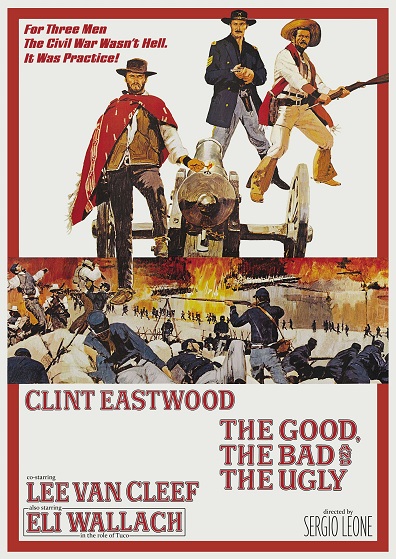
The Good, the Bad and the Ugly (50th Anniversary Edition)
Studio: Kino Lorber Studio Classics
Aug 18, 2017
Web Exclusive
![]()
Released fifty years ago, no one expected Sergio Leone’s The Good, The Bad and The Ugly to become one of the defining films of the so-called “Spaghetti Western” genre. When released, the Western genre was seen as passé, and it didn’t help that the film was poorly synched and ran for nearly three hours. As unlikely as it seems now, critics largely did not care for the film for those rather valid points. But positive critical assessment and artistic merit often do not go hand in hand, as the critics aren’t always right. In the case of The Good, The Bad and The Ugly, they got it wrong. The audience knew better, too; it was a commercial success, in spite of the critical panning.
The plot itself is simple enough: during the Civil War, three men are on a quest to find a missing treasure chest of stolen Confederate gold—Angel Eyes, an assasin (Lee Van Cleef), Tuco, a violent criminal, (Eli Wallach), and Blondie, a man of mysterious background (Clint Eastwood). When Angel Eyes learns of a stolen treasure chest of Confederate gold, he sets on a quest to locate it. Meanwhile, Blondie and Tuco—who had worked together scamming law enforcement—have a falling out and are seeking to kill each other, and while pursuing each other they too learn of this treasure. Thus, the race is on to find it, as it’s buried in a war cemetery in New Mexico. The trio of men then form an uneasy alliance, wary of each other, but each wanting to split the reward, and must pose as soldiers order to get closer to the cemetery, leading to a breathtaking, emotional, hair-raising finale, made even more thrilling by Leone’s tactic of delaying the action while building up the symphonic score.
Though the film is now considered a genuine masterpiece, the criticisms mentioned above are indeed fair. At nearly three hours, the full-length film can occasionally slow to a glacial pace. The synch track is indeed poor, as Leone did not utilize synch recording, told his actors to speak in their native language, then dubbed over dialogue in post-production, practically insuring that the English, Italian, and Spanish versions of the film would all have synching problems. And though Leone was on the way to becoming the most well-known “Spaghetti Western” director, in 1967, his reputation had yet to be solidified outside of Italy and mainland Europe, though his two films, A Fistful of Dollars and For a Few Dollars More had been released in America to general acclaim, and in the process introduced the world to the talents of Clint Eastwood, Sergio Leone, Ennio Morricone, and Eli Wallach.
This fiftieth edition set, however, offers up a plethora of information about the making of the film, all gathered from previous DVD releases as well as from outside sources and interviews. There’s a lot of information and backstory to learn about the making of a classic, from the picayune and trivial—Eastwood bought several cartons of the cheapest cigars at a local Hollywood convenience store, ones that would cause him visible disgust when smoking them onscreen—to the revelatory. For instance, it has long been assumed that Leone did not know much about the history of the Civil War, yet the setting for the film is based on an extremely obscure historical incident that has gone relatively forgotten, as featured in the documentary, “The Man Who Lost The Civil War.”
Yet when one watches the film—here offered in the original American theatrical cut and the extended original Italian version—these problems quickly become moot. Propelled by amazing cinematography and a fantastic orchestral score composed by Ennio Morricone, The Good, The Bad and The Ugly is a magnificent and occasionally overwhelming viewing experience, one that sucks its viewers in and has on offer new discoveries for the viewer returning to it. This massive set offers up a definitive look at one of the greatest Western films of the 20th century.
www.kinolorber.com/product/view/id/4552
Current Issue

Issue #72
Apr 19, 2024 Issue #72 - The ‘90s Issue with The Cardigans and Thurston Moore
Most Recent
- Premiere: Slow Joy Releases New Single and Video for “King Cowboy” (News) —
- Hovvdy (Review) —
- Descendents, Circle Jerks @ Brooklyn Paramount, NYC, April 13, 2024 (Review) —
- Bat For Lashes Shares a Cover of Baauer’s “Home” From Her New Album (News) —
- Premiere: Veronica Lewis Shares New Single “Disconnected” (News) —

Comments
Submit your comment
There are no comments for this entry yet.